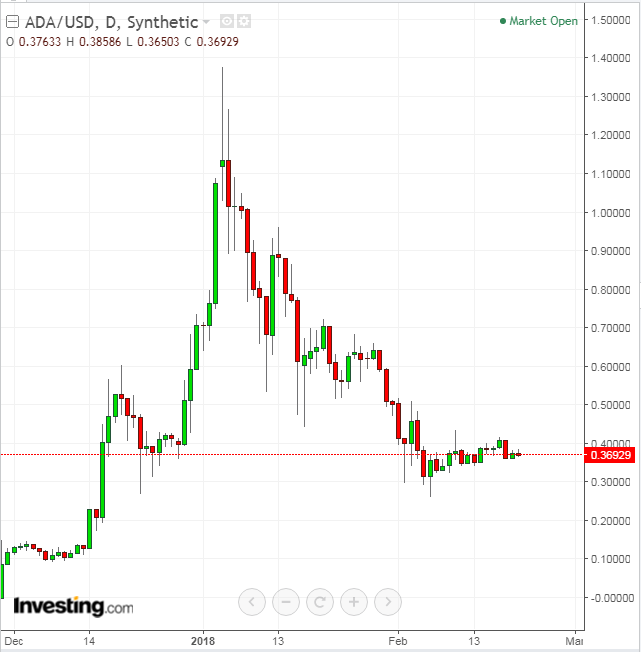Though the entire cryptocurrency asset class is relatively new, and myriad novel alt-coins are introduced on a regular and ongoing basis, how is it that Cardano (ADA/USD), released just a bit more than four months ago, has already become the sixth most popular digital currency, competing with bigger and more expensive 'peers' including Bitcoin, Litecoin, Ethereum Ripple and Bitcoin Cash.

Started as a blockchain project under founder Charles Hoskinson, the co-founder of Ethereum, and released on September 29, 2017, today Cardano has a market cap of $10.15B and trades for 0.367 per coin at time of writing. What makes it worthy of such a high valuation as such an early stage?
It's a third generation blockchain platform and currency, something still rare for this newly developing asset class. That's why many believe Cardano will take blockchain technology to a whole new level.
Michael Parsons explains that Cardano is an amalgamation of three entities, the Cardano Foundation, of which he's chairman, IOHK—a tech company founded by Hoskins and Jeremy Wood—and Emurgo, an incubator for commercial ventures in the blockchain space. They've banded together with a mandate to build a third generation blockchain that addresses issues around scalability, sustainability and inter-operability.
Parsons elaborates:
“Cardano is a decentralized open source blockchain that will support a smart contract platform with more advanced features. Built in Haskell - an advanced and more precise coding language - the protocol has emerged following extensive academic peer review with a clear roadmap for development.”
As with so many other alt-currencies, Cardano provides a means of exchanging digital value without an intermediary, but at a more advanced level than the bulk of its competitors, enabling a more complex system of smart contracts so that users can customize transactions. Parsons notes that blockchain continues to advance at a rapid pace, but highlights that problems persist. Issues include a lack of scalability and proper governance, as well as compatibility issues on the Bitcoin and Ethereum platforms, driving the need for a new approach.
Andrey Solovyev, a software engineer with an academic background in applied mathematics who is also co-founder and head of product for mom.life, explains that Cardano utilizes a multi-layered infrastructure. The accounting layer is separate from the smart contract execution layer. This is a signifcant innovation, he says, since it allows for absolute flexibility in protocol utilization, app development and security systems.
It’s all in the Coding Language
In order to truly understand what makes Cardano both unique and valuable, a deeper drilldown into the technology underlying this cryptocurrency is helpful. Cardano’s smart contract language, sometimes also referred to as a programming language, is called Plutus. The syntax is Haskell-like, meaning it follows to some degree the general-purpose, Haskell programming language, but with suitable alterations. Indeed, some might characterize it as Haskell-lite.
But unlike Haskell, Plutus has been assiduously evaluated and adapted for high security funcionality. As well, Cradano's reputation rests on Ouroborous, its peer reviewed white paper. Says Solovyev:
“What is particularly important for consumer applications is the new smart contract development language Plutus (substantially based on Haskell) delivering full compatibility of the apps built on Cardano - with external systems. No less importantly, the original consensus mechanism Ouroboros delivers computational scalability by using quorum thresholds to select consensus node batches that divide the transactional and consensus flow, whereas the more conventional protocols utilize all nodes to confirm and record all transactions.”
Proof-of-Work vs Proof-of-Stake
Bitcoin, as well as most other cryptocurrencies, rely on a proof-of-work algorithm, which requires miners to solve complex mathematical puzzles referred to as 'proof-of-work' problems. As the chain of blocks needed to continue to build this system grows, additional time and electrical energy is required for each new block, slowing down transactions as popularity increases.
Conversely, one key component of Ouroboros is its proof-of-stake consensus algorithm which requires users to perform some computational work, but determines ownership by your stake in the currency, ie how much you own.
Jeff Mahony, CEO and co-founder of UBIQUICOIN, a decentralized digital currency, is positive on Cardano. He believes that any proof-of-work consensus model is ultimately poised for failure in the cryptocurrency space. He points out that in private use models, the Cardano platform has shown real promise.
Third Generation Blockchain
What's the significance of Cardano's position as third generation blockchain? It means that Cardano's platform has evolved from earlier smart contract protocols, making it more reliable and secure than older, alternative platforms. Parsons notes that proper oversight of the development process is a key part of developing a third-generation blockchain. His justification for the additional stewardship is also a crucial reason for its rapid uptake:
“That is why we appointed software experts, FP Complete, to conduct a rigorous audit of the Cardano protocol and work undertaken by developers, IOHK. This audit process was always part of our development plan and demonstrates a commitment to transparency for our users”
